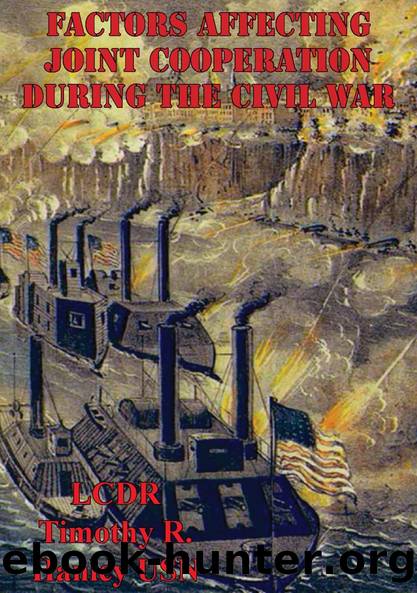Factors Affecting Joint Cooperation During The Civil War by LCDR Timothy R. Hanley USN

Author:LCDR Timothy R. Hanley USN [USN, LCDR Timothy R. Hanley]
Language: eng
Format: epub
ISBN: 9781782899372
Barnesnoble:
Publisher: Golden Springs Publishing
Published: 2015-11-06T00:00:00+00:00
Reprinted with permission from Combined Operations in the Civil War by Rowena Reed. Copyright c 1978, U.S. Naval Institute, Annapolis, MD.
The precipitate retreat from the Stono was one of the first problems in joint cooperation to surface. DuPontâs opinion of the Armyâs capability was becoming more negative as time went on. Shortly after the withdrawal he complained to the Assistant Secretary of the Navy: âOh those Soldiers, I put them nearly on top of the house in Charleston, but I did not push them into the windows and they came back.â{113}
Although DuPontâs criticism was minor, it marked a subtle but important shift in the tone of the relationship between the services. Until shortly after Hunterâs assumption of command of the Department of the South in late March, there had been numerous small, but successful, joint operations all along the coast, from the Stono south to St. Augustine, Florida. The subordinate commanders from both services realized that both branches working together could achieve more than either could separately.
Some of those successes could be laid to the cordial relationship between DuPont and Hunterâs predecessor, Brigadier General T. W. Sherman. Sherman was a stolid if unimaginative general who was willing to defer to DuPont on joint matters. Hunter was a political general, who like Ben Butler had to be humored by Lincoln for the sake of the war effort. Hunter was unwilling to accept or imply any degree of subordination to DuPont, a situation bound to cause friction with the touchy and prerogative-obsessed Admiral.
Another factor, besides the change in Army commanders, was that DuPont himself had undergone a transformation from the time of his aggressive attack on Port Royal. The tedium of occupation and blockade duty set in. From the winter of 1861 onward, his official correspondence with the Navy Department dealt increasingly with administrative details and less and less with operational matters. His ideas and proposals regarding new operations against the enemy became rarer as time went on.{114} A man who is losing interest in initiative may find it to be an irritating quality in a colleague whom he is required to work with closely. Despite his poor showing at James Island, Hunter would prove to be the more aggressive commander.
One lasting effect of the Battle of Seccessionville was that the War Department came to view the Charleston area as expensive sideshow. After the Seccessionville fight, the War Department withdrew seven of Hunterâs regiments to reinforce other theaters, leaving him with insufficient forces to renew offensive operations against Charleston. A manpower shortage would hobble the Armyâs efforts near Charleston for the remainder of the war.{115} Secretary of War Stanton and his Chief of Staff, Major General H. W. Halleck, were willing to let the Army cooperate with the Navy in any attempt to seize Charleston but they were unwilling to commit substantial numbers of new troops to it.
âAfter the failure of the assault of Seccessionville and the abandonment by the Federal troops of the footholds they had secured on James Island in
Download
This site does not store any files on its server. We only index and link to content provided by other sites. Please contact the content providers to delete copyright contents if any and email us, we'll remove relevant links or contents immediately.
| United States | Abolition |
| Campaigns & Battlefields | Confederacy |
| Naval Operations | Regimental Histories |
| Women |
In Cold Blood by Truman Capote(3343)
The Innovators: How a Group of Hackers, Geniuses, and Geeks Created the Digital Revolution by Walter Isaacson(2979)
Steve Jobs by Walter Isaacson(2855)
All the President's Men by Carl Bernstein & Bob Woodward(2346)
Lonely Planet New York City by Lonely Planet(2190)
And the Band Played On by Randy Shilts(2163)
The Room Where It Happened by John Bolton;(2132)
The Poisoner's Handbook by Deborah Blum(2108)
The Murder of Marilyn Monroe by Jay Margolis(2076)
The Innovators by Walter Isaacson(2073)
Lincoln by David Herbert Donald(1962)
A Colony in a Nation by Chris Hayes(1898)
Being George Washington by Beck Glenn(1771)
Under the Banner of Heaven: A Story of Violent Faith by Jon Krakauer(1763)
Amelia Earhart by Doris L. Rich(1668)
The Unsettlers by Mark Sundeen(1658)
Dirt by Bill Buford(1649)
Birdmen by Lawrence Goldstone(1637)
Zeitoun by Dave Eggers(1613)
